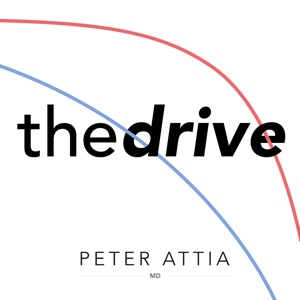#334 - Cardiovascular disease, the number one killer: development, biomarkers, apoB, cholesterol, brain health, and more | Tom Dayspring, M.D.
The Peter Attia Drive - A podcast by Peter Attia, MD - Mondays

View the Show Notes Page for This Episode Become a Member to Receive Exclusive Content Sign Up to Receive Peter’s Weekly Newsletter Tom Dayspring is a world-renowned expert in clinical lipidology and a previous guest on The Drive. In this episode, Tom explores the foundations of atherosclerosis and why atherosclerotic cardiovascular disease (ASCVD) is the leading cause of death worldwide for both men and women. He examines how the disease develops from a pathological perspective and discusses key risk factors, including often-overlooked contributors such as insulin resistance and chronic kidney disease. He breaks down the complexities of cholesterol and lipoproteins—including LDL, VLDL, IDL, and HDL—with an in-depth discussion on the critical role of apolipoprotein B (apoB) in the development of atherosclerosis. Additionally, he covers the importance of testing various biomarkers, the impact of nutrition on lipid levels, and the vital role of cholesterol in brain health, including how cholesterol is synthesized and managed in the brain, how it differs from cholesterol regulation in the rest of the body, and how pharmacological interventions can influence brain cholesterol metabolism. We discuss: Defining atherosclerotic cardiovascular disease (ASCVD): development, risks, and physiological impact [2:45]; The pathogenesis of ASCVD: the silent development over decades, and the importance of early detection for prevention of adverse outcomes [10:45]; Risk factors versus risk markers for ASCVD, and how insulin resistance and chronic kidney disease contribute to atherosclerosis [17:30]; How hyperinsulinemia elevates cardiovascular risk [24:00]; How apoB-containing lipoproteins contribute to atherosclerosis, and why measuring apoB is a superior indicator of cardiovascular risk compared to LDL cholesterol [29:45]; The challenges of detecting early-stage atherosclerosis before calcification appears [46:15]; Lp(a): structure, genetic basis, and significant risks associated with elevated Lp(a) [55:30]; How aging and lifestyle factors contribute to rising apoB and LDL cholesterol levels, and the lifestyle changes that can lower it [59:45]; How elevated triglycerides, driven by insulin resistance, increase apoB particle concentration and promote atherosclerosis [1:08:00]; How LDL particle size, remnant lipoproteins, Lp(a), and non-HDL cholesterol contribute to cardiovascular risk beyond apoB levels [1:21:45]; The limitations of using HDL cholesterol as a marker for heart health [1:29:00]; The critical role of cholesterol in brain function and how the brain manages its cholesterol supply [1:36:30]; The impact of ApoE genotype on brain health and Alzheimer's disease risk [1:46:00]; How the brain manages cholesterol through specialized pathways, and biomarkers to track cholesterol health of the brain [1:50:30]; How statins might affect brain cholesterol synthesis and cognitive function, and alternative lipid-lowering strategies for high-risk individuals [1:57:30]; Exciting advancements in therapeutics, diagnostics, and biomarkers coming in the next few years [2:09:30]; Recent consensus statements on apoB and Lp(a) from the National Lipid Association (NLA) [2:12:30]; and More. Connect With Peter on Twitter, Instagram, Facebook and YouTube
